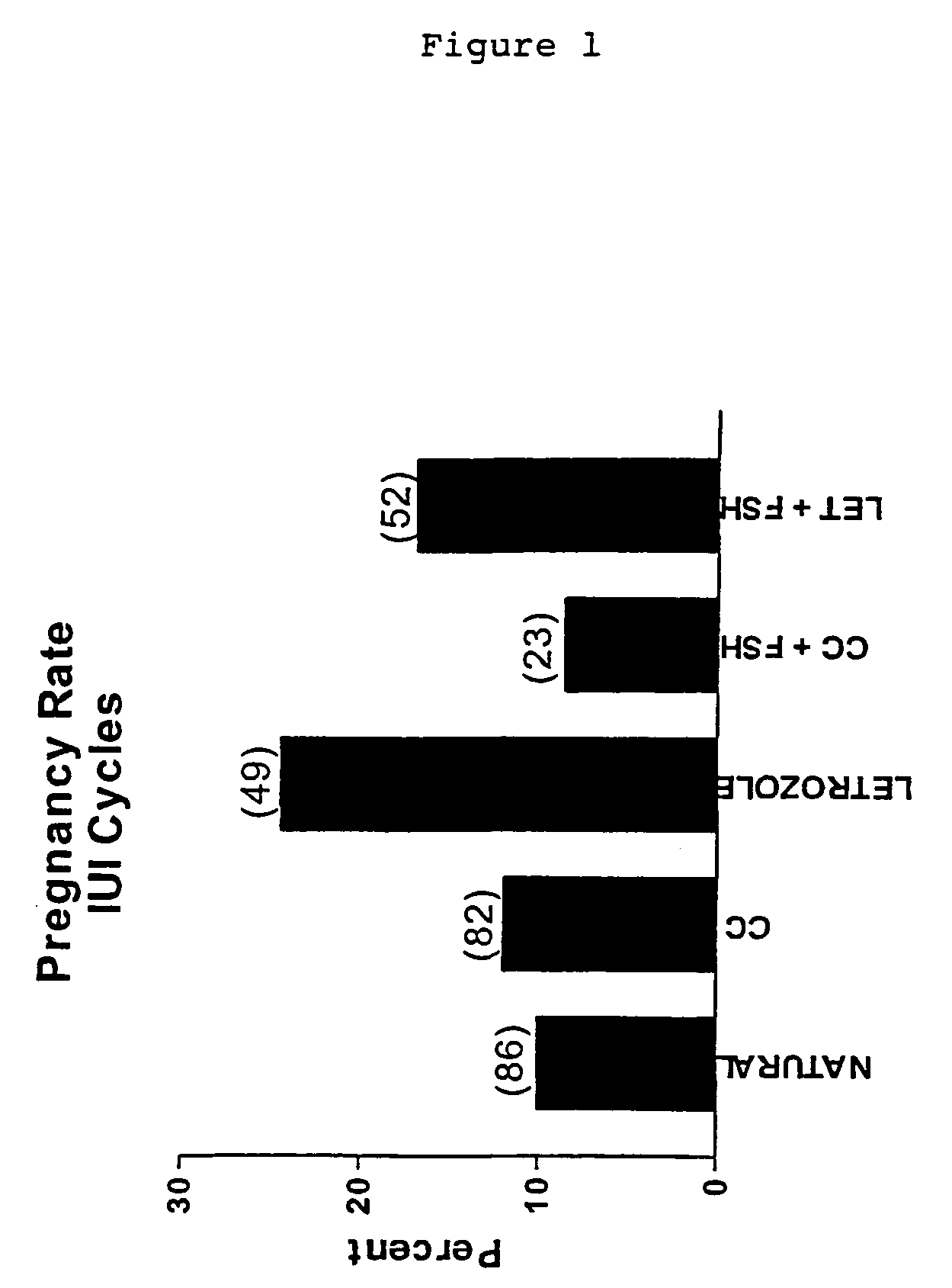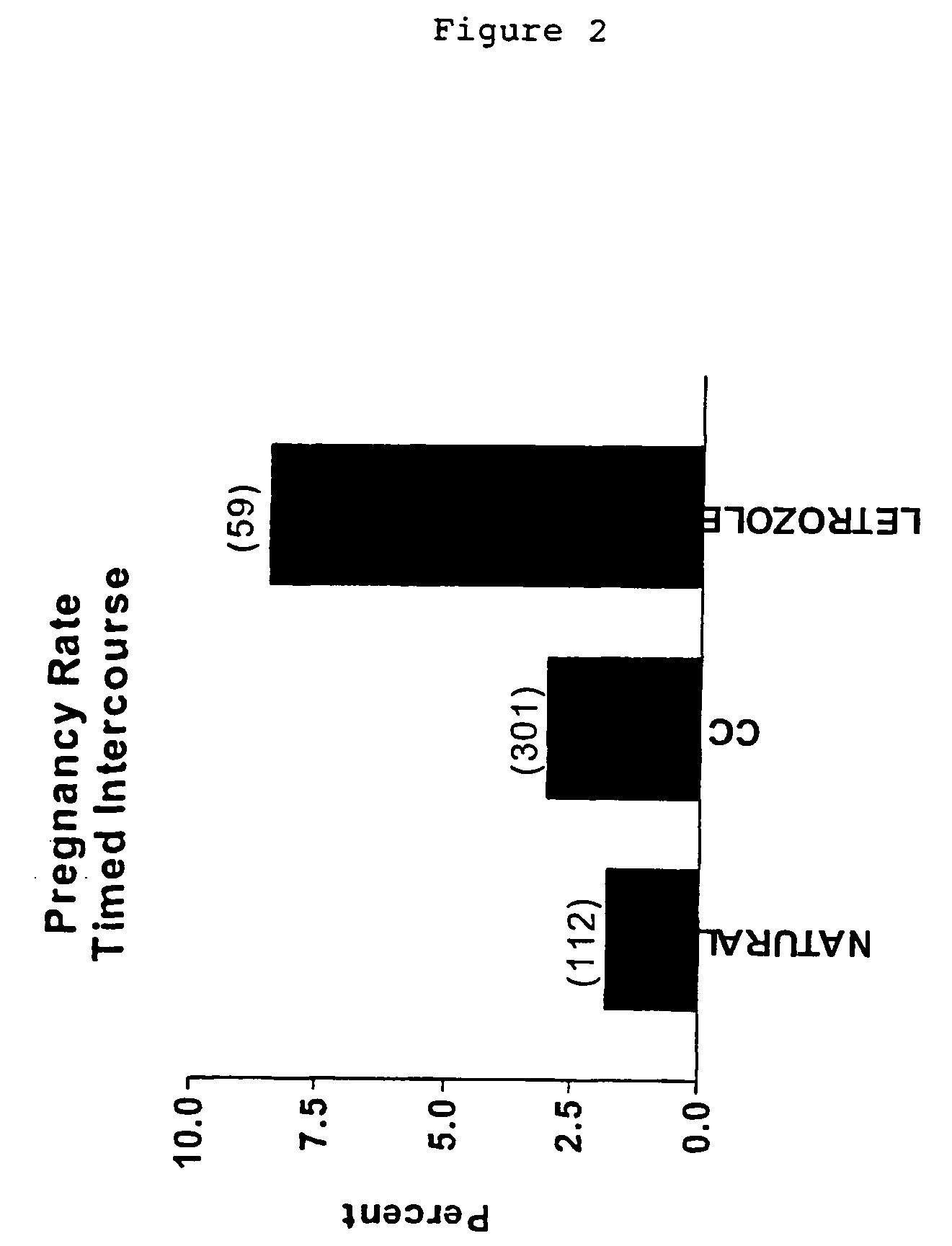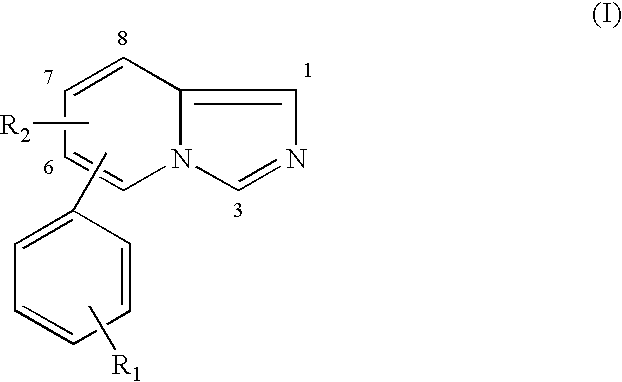Multiple dose aromatase inhibitor for treating infertility
a technology of aromatase inhibitors and aromatase inhibitors, which is applied in the field of aromatase inhibitors with multiple doses, can solve the problems of long-lasting depletion of estrogen receptors, difficult control of hmg or fsh treatment, and high frequency of multiple pregnancies, so as to prevent androgen conversion to estrogen, increase intra-ovarian androgen concentration, and increase gonadotropin secretion
- Summary
- Abstract
- Description
- Claims
- Application Information
AI Technical Summary
Benefits of technology
Problems solved by technology
Method used
Image
Examples
example 1
[0349]In this example the use of the AI, letrozole, for ovulation induction in 10 patients who either failed to ovulate (n=3) or ovulated with an endometrial thickness <5 mm (n=7) in response to CC administration was examined. In all patients, letrozole treatment was given orally, at least two months after the last CC cycle, in a dose of 2.5 to 5 mg / day, from days 3 to 7 or 5 to 9 of the menstrual cycle. HCG 10,000 IU was given to all except one patient to trigger ovulation. Ten patients completed 12 cycles (one patient completed three cycles). Ovulation occurred in 9 cycles (75%) and pregnancy in 4 out of 10 patients (40%). The data is presented in Table 1 below.
[0350]
TABLE 1FolliclesEstradiolLH on>1.5 CmEndo-on dayday ofDay ofOn daymetrialof HCGHCGHCGof HCGThicknessadmin.admin.Ageadmin.admin.(Cm.)(pmol)(IU / L)Mean33.41520.8103616Range28-4011-181-30.6-0.9107-23473.1-66Median33.51520.8 988 7.8
[0351]From the above-mentioned data, the use of letrozole for obtaining multiple follicles i...
example 2
[0352]Eight patients with unexplained infertility undergoing intrauterine insemination (IUI) received hFSH (human FSH) from cycle day 3 and were considered poor responders (2 cm followed by IUI. The mean+SD age and duration of infertility were 36.5+2.96 and 4.6+1.2 years, respectively. The data appears in Table 2 below.
[0353]
TABLE 2FSH onlyLetrozole + FSHP(16 cycles)(8 cycles)valueFSH / cycle (IU)1469 + 498 603 + 510Stimulation days / cycle9.1 + 3 6.8 + 2.4NSDay of HCG administration12.2 + 2.9 13.3 + 2.1 NSNumber of mature follicles1.88 + 0.7 3.5 + 1.3E2 on HCG day (pmol / L)1893 + 10661689 + 1044NSE2 / mature follicle on HCG1097 + 557 483 + 259day (pmol / L)Endometrial thickness on0.92 + 0.150.93 + 0.14NSHCG day (cm)LH on HCG day (IU / L)14.7 + 13.210.4 + 8.5 NSNS = Not significant
[0354]During letrozole+FSH cycles two pregnancies were achieved (25%). In this example, a potential benefit of letrozole for improving ovarian response to FSH in poor responders is shown. The dose of FSH was signifi...
example 3
[0355]Fifteen patients who either failed to ovulate (6 cycles) or ovulated with an endometrial thickness <5 mm (24 cycles) in response to CC and who did not conceive were given letrozole orally, at least two months after the last CC cycle, in a dose of 2.5 to 5 mg / day, from day 3 to 7 or 5 to 9 of the menstrual cycle. HCG 10,000 IU was given to trigger ovulation. CC was given in a dose of 50-100 mg on days 3-7 or 5-9.
[0356]Fifteen patients completed 17 letrozole cycles. Ovulation occurred in 13 cycles (77%) and pregnancy in 5 out of 15 patients (33%). The following table shows summary of CC and letrozole cycles.
[0357]
TABLE 3MeanRangeMedianTreatmentLetrozoleCCPLetrozoleCCLetrozoleCCDay of hCG14.512.6S11-1811-161512administrationNumber of Days from6.74.4S2-92-774last letrozole tablet toHCG dayEndometrial Thickness0.80.5S0.6-1.10.4-0.80.80.4(Cm.)Follicles >1.5 Cm on2.41.9NS1-31-522day of hCGadministrationEstradiol (pmol / L) on10162145S 107-2347 362-52109011668day of hCGadministrationEst...
PUM
| Property | Measurement | Unit |
|---|---|---|
| Time | aaaaa | aaaaa |
| Mass | aaaaa | aaaaa |
| Mass | aaaaa | aaaaa |
Abstract
Description
Claims
Application Information
 Login to View More
Login to View More - R&D
- Intellectual Property
- Life Sciences
- Materials
- Tech Scout
- Unparalleled Data Quality
- Higher Quality Content
- 60% Fewer Hallucinations
Browse by: Latest US Patents, China's latest patents, Technical Efficacy Thesaurus, Application Domain, Technology Topic, Popular Technical Reports.
© 2025 PatSnap. All rights reserved.Legal|Privacy policy|Modern Slavery Act Transparency Statement|Sitemap|About US| Contact US: help@patsnap.com



